Comparative Analysis of DC Motors: Construction, Operation, and Adv
VerifiedAdded on 2022/10/17
|5
|1185
|463
Report
AI Summary
This report provides a comprehensive comparison of brushed and brushless DC motors, detailing their construction, operational principles, advantages, and disadvantages. It further extends the comparison to include DC series and shunt motors, analyzing their structural differences, operational methods, and respective pros and cons. The analysis covers key aspects such as the use of brushes, commutators, and electronic commutation in various motor types, along with the presence of field windings and permanent magnets. The report highlights the efficiency, maintenance requirements, and cost implications associated with each motor type, supported by relevant figures and references. It emphasizes the application of hall effect sensors in brushless DC motors and contrasts the operational characteristics of each motor type, providing a clear understanding of their suitability for different applications.
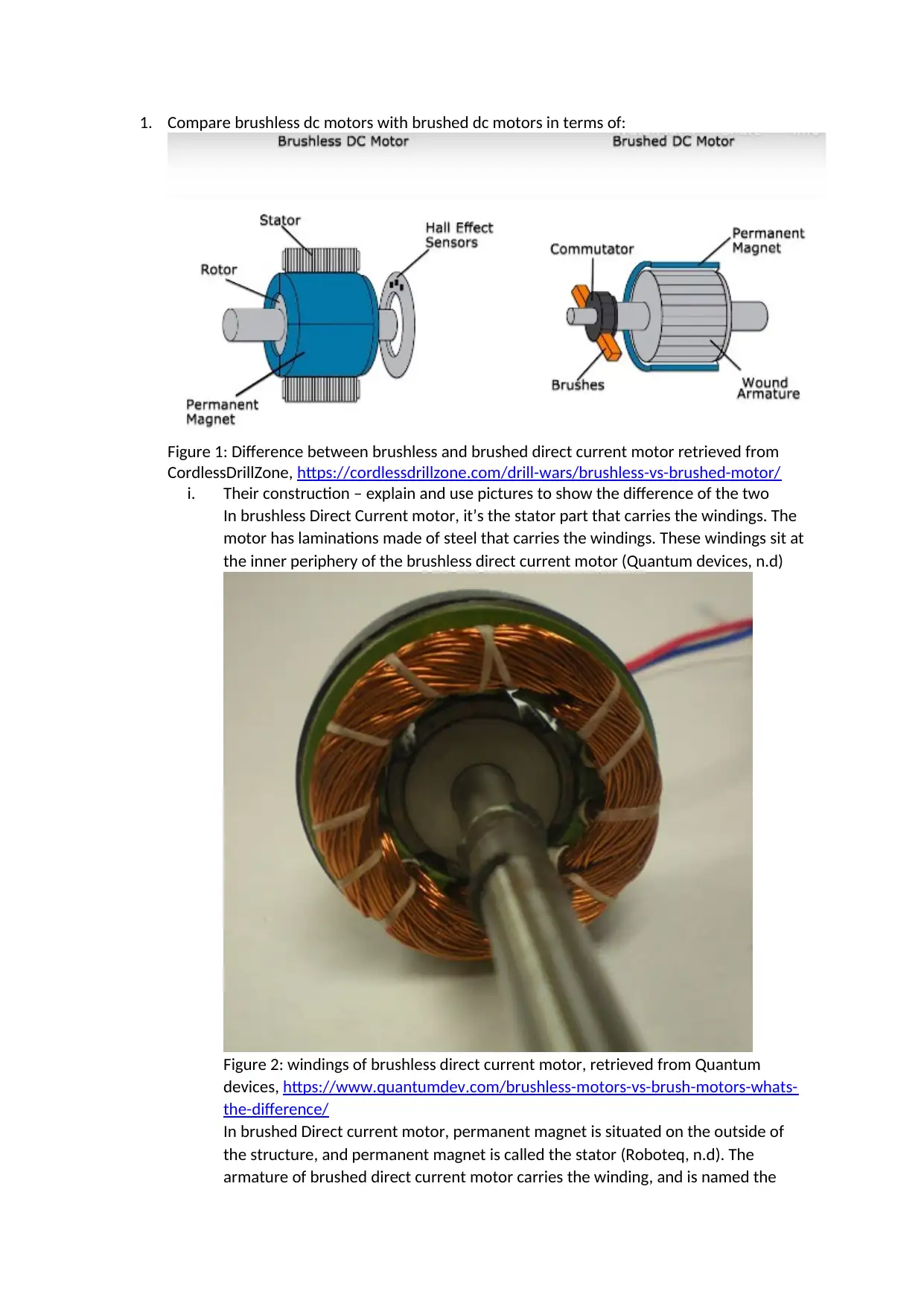
1. Compare brushless dc motors with brushed dc motors in terms of:
Figure 1: Difference between brushless and brushed direct current motor retrieved from
CordlessDrillZone, https://cordlessdrillzone.com/drill-wars/brushless-vs-brushed-motor/
i. Their construction – explain and use pictures to show the difference of the two
In brushless Direct Current motor, it’s the stator part that carries the windings. The
motor has laminations made of steel that carries the windings. These windings sit at
the inner periphery of the brushless direct current motor (Quantum devices, n.d)
Figure 2: windings of brushless direct current motor, retrieved from Quantum
devices, https://www.quantumdev.com/brushless-motors-vs-brush-motors-whats-
the-difference/
In brushed Direct current motor, permanent magnet is situated on the outside of
the structure, and permanent magnet is called the stator (Roboteq, n.d). The
armature of brushed direct current motor carries the winding, and is named the
Figure 1: Difference between brushless and brushed direct current motor retrieved from
CordlessDrillZone, https://cordlessdrillzone.com/drill-wars/brushless-vs-brushed-motor/
i. Their construction – explain and use pictures to show the difference of the two
In brushless Direct Current motor, it’s the stator part that carries the windings. The
motor has laminations made of steel that carries the windings. These windings sit at
the inner periphery of the brushless direct current motor (Quantum devices, n.d)
Figure 2: windings of brushless direct current motor, retrieved from Quantum
devices, https://www.quantumdev.com/brushless-motors-vs-brush-motors-whats-
the-difference/
In brushed Direct current motor, permanent magnet is situated on the outside of
the structure, and permanent magnet is called the stator (Roboteq, n.d). The
armature of brushed direct current motor carries the winding, and is named the
Paraphrase This Document
Need a fresh take? Get an instant paraphrase of this document with our AI Paraphraser
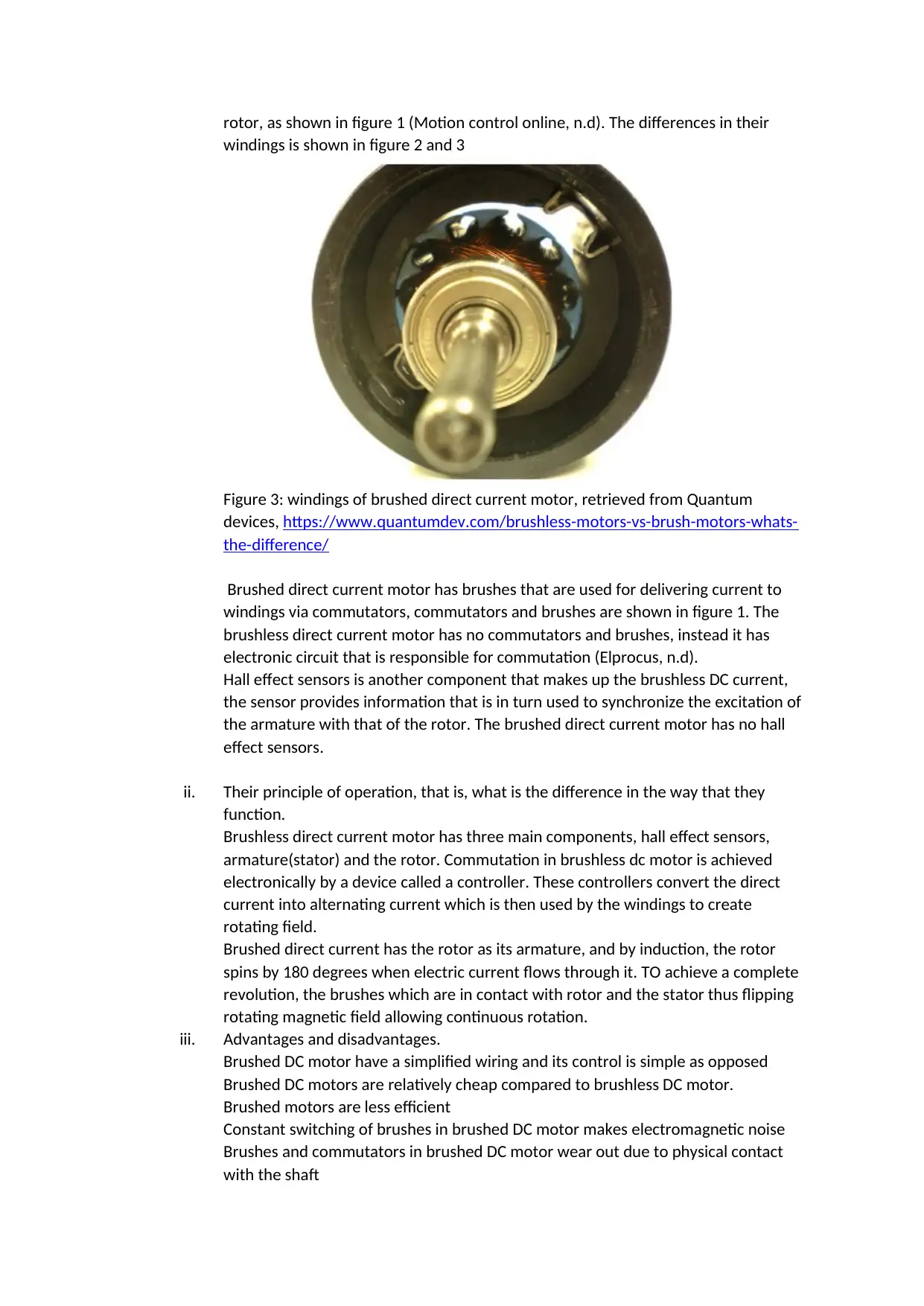
rotor, as shown in figure 1 (Motion control online, n.d). The differences in their
windings is shown in figure 2 and 3
Figure 3: windings of brushed direct current motor, retrieved from Quantum
devices, https://www.quantumdev.com/brushless-motors-vs-brush-motors-whats-
the-difference/
Brushed direct current motor has brushes that are used for delivering current to
windings via commutators, commutators and brushes are shown in figure 1. The
brushless direct current motor has no commutators and brushes, instead it has
electronic circuit that is responsible for commutation (Elprocus, n.d).
Hall effect sensors is another component that makes up the brushless DC current,
the sensor provides information that is in turn used to synchronize the excitation of
the armature with that of the rotor. The brushed direct current motor has no hall
effect sensors.
ii. Their principle of operation, that is, what is the difference in the way that they
function.
Brushless direct current motor has three main components, hall effect sensors,
armature(stator) and the rotor. Commutation in brushless dc motor is achieved
electronically by a device called a controller. These controllers convert the direct
current into alternating current which is then used by the windings to create
rotating field.
Brushed direct current has the rotor as its armature, and by induction, the rotor
spins by 180 degrees when electric current flows through it. TO achieve a complete
revolution, the brushes which are in contact with rotor and the stator thus flipping
rotating magnetic field allowing continuous rotation.
iii. Advantages and disadvantages.
Brushed DC motor have a simplified wiring and its control is simple as opposed
Brushed DC motors are relatively cheap compared to brushless DC motor.
Brushed motors are less efficient
Constant switching of brushes in brushed DC motor makes electromagnetic noise
Brushes and commutators in brushed DC motor wear out due to physical contact
with the shaft
windings is shown in figure 2 and 3
Figure 3: windings of brushed direct current motor, retrieved from Quantum
devices, https://www.quantumdev.com/brushless-motors-vs-brush-motors-whats-
the-difference/
Brushed direct current motor has brushes that are used for delivering current to
windings via commutators, commutators and brushes are shown in figure 1. The
brushless direct current motor has no commutators and brushes, instead it has
electronic circuit that is responsible for commutation (Elprocus, n.d).
Hall effect sensors is another component that makes up the brushless DC current,
the sensor provides information that is in turn used to synchronize the excitation of
the armature with that of the rotor. The brushed direct current motor has no hall
effect sensors.
ii. Their principle of operation, that is, what is the difference in the way that they
function.
Brushless direct current motor has three main components, hall effect sensors,
armature(stator) and the rotor. Commutation in brushless dc motor is achieved
electronically by a device called a controller. These controllers convert the direct
current into alternating current which is then used by the windings to create
rotating field.
Brushed direct current has the rotor as its armature, and by induction, the rotor
spins by 180 degrees when electric current flows through it. TO achieve a complete
revolution, the brushes which are in contact with rotor and the stator thus flipping
rotating magnetic field allowing continuous rotation.
iii. Advantages and disadvantages.
Brushed DC motor have a simplified wiring and its control is simple as opposed
Brushed DC motors are relatively cheap compared to brushless DC motor.
Brushed motors are less efficient
Constant switching of brushes in brushed DC motor makes electromagnetic noise
Brushes and commutators in brushed DC motor wear out due to physical contact
with the shaft
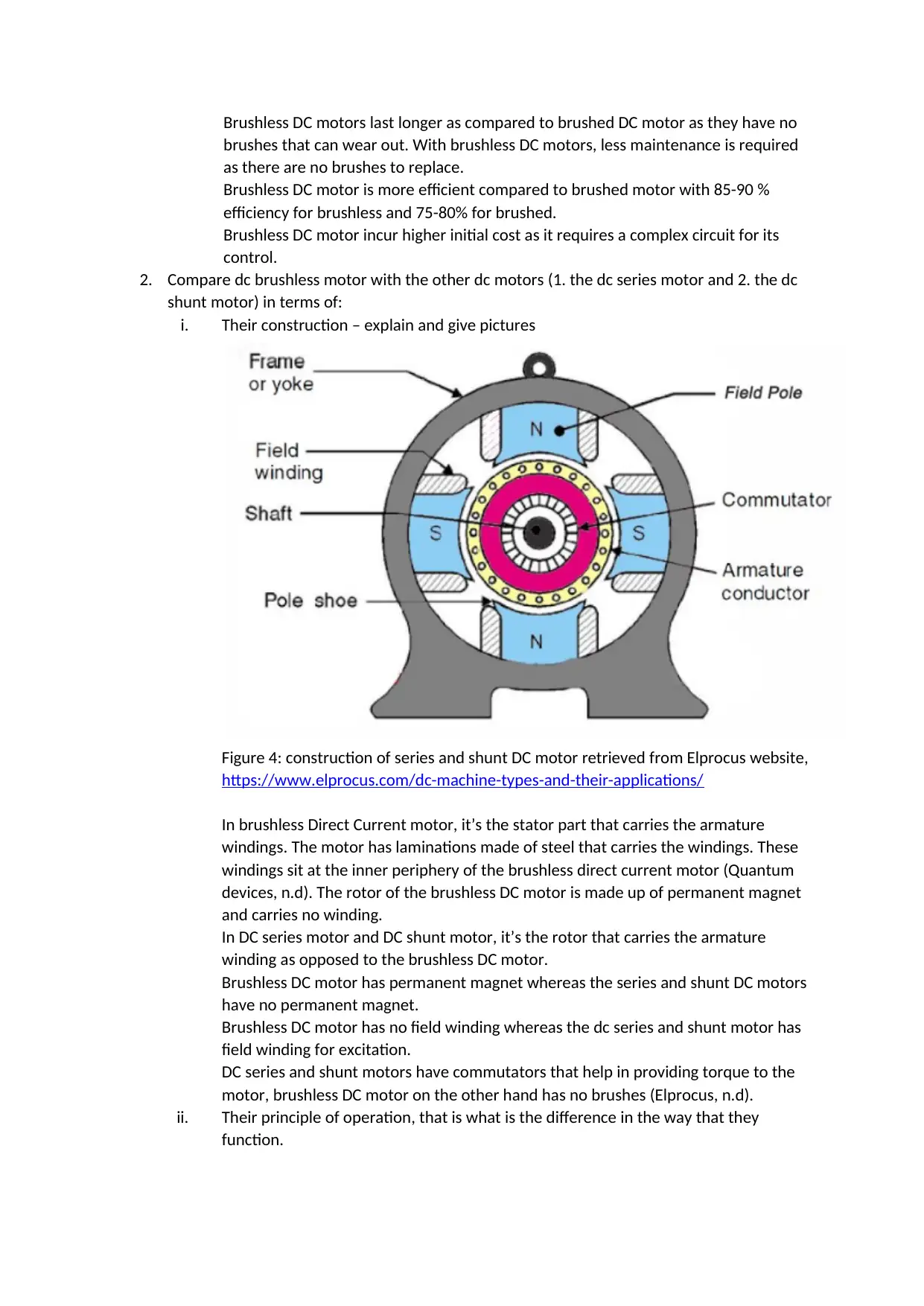
Brushless DC motors last longer as compared to brushed DC motor as they have no
brushes that can wear out. With brushless DC motors, less maintenance is required
as there are no brushes to replace.
Brushless DC motor is more efficient compared to brushed motor with 85-90 %
efficiency for brushless and 75-80% for brushed.
Brushless DC motor incur higher initial cost as it requires a complex circuit for its
control.
2. Compare dc brushless motor with the other dc motors (1. the dc series motor and 2. the dc
shunt motor) in terms of:
i. Their construction – explain and give pictures
Figure 4: construction of series and shunt DC motor retrieved from Elprocus website,
https://www.elprocus.com/dc-machine-types-and-their-applications/
In brushless Direct Current motor, it’s the stator part that carries the armature
windings. The motor has laminations made of steel that carries the windings. These
windings sit at the inner periphery of the brushless direct current motor (Quantum
devices, n.d). The rotor of the brushless DC motor is made up of permanent magnet
and carries no winding.
In DC series motor and DC shunt motor, it’s the rotor that carries the armature
winding as opposed to the brushless DC motor.
Brushless DC motor has permanent magnet whereas the series and shunt DC motors
have no permanent magnet.
Brushless DC motor has no field winding whereas the dc series and shunt motor has
field winding for excitation.
DC series and shunt motors have commutators that help in providing torque to the
motor, brushless DC motor on the other hand has no brushes (Elprocus, n.d).
ii. Their principle of operation, that is what is the difference in the way that they
function.
brushes that can wear out. With brushless DC motors, less maintenance is required
as there are no brushes to replace.
Brushless DC motor is more efficient compared to brushed motor with 85-90 %
efficiency for brushless and 75-80% for brushed.
Brushless DC motor incur higher initial cost as it requires a complex circuit for its
control.
2. Compare dc brushless motor with the other dc motors (1. the dc series motor and 2. the dc
shunt motor) in terms of:
i. Their construction – explain and give pictures
Figure 4: construction of series and shunt DC motor retrieved from Elprocus website,
https://www.elprocus.com/dc-machine-types-and-their-applications/
In brushless Direct Current motor, it’s the stator part that carries the armature
windings. The motor has laminations made of steel that carries the windings. These
windings sit at the inner periphery of the brushless direct current motor (Quantum
devices, n.d). The rotor of the brushless DC motor is made up of permanent magnet
and carries no winding.
In DC series motor and DC shunt motor, it’s the rotor that carries the armature
winding as opposed to the brushless DC motor.
Brushless DC motor has permanent magnet whereas the series and shunt DC motors
have no permanent magnet.
Brushless DC motor has no field winding whereas the dc series and shunt motor has
field winding for excitation.
DC series and shunt motors have commutators that help in providing torque to the
motor, brushless DC motor on the other hand has no brushes (Elprocus, n.d).
ii. Their principle of operation, that is what is the difference in the way that they
function.
⊘ This is a preview!⊘
Do you want full access?
Subscribe today to unlock all pages.

Trusted by 1+ million students worldwide
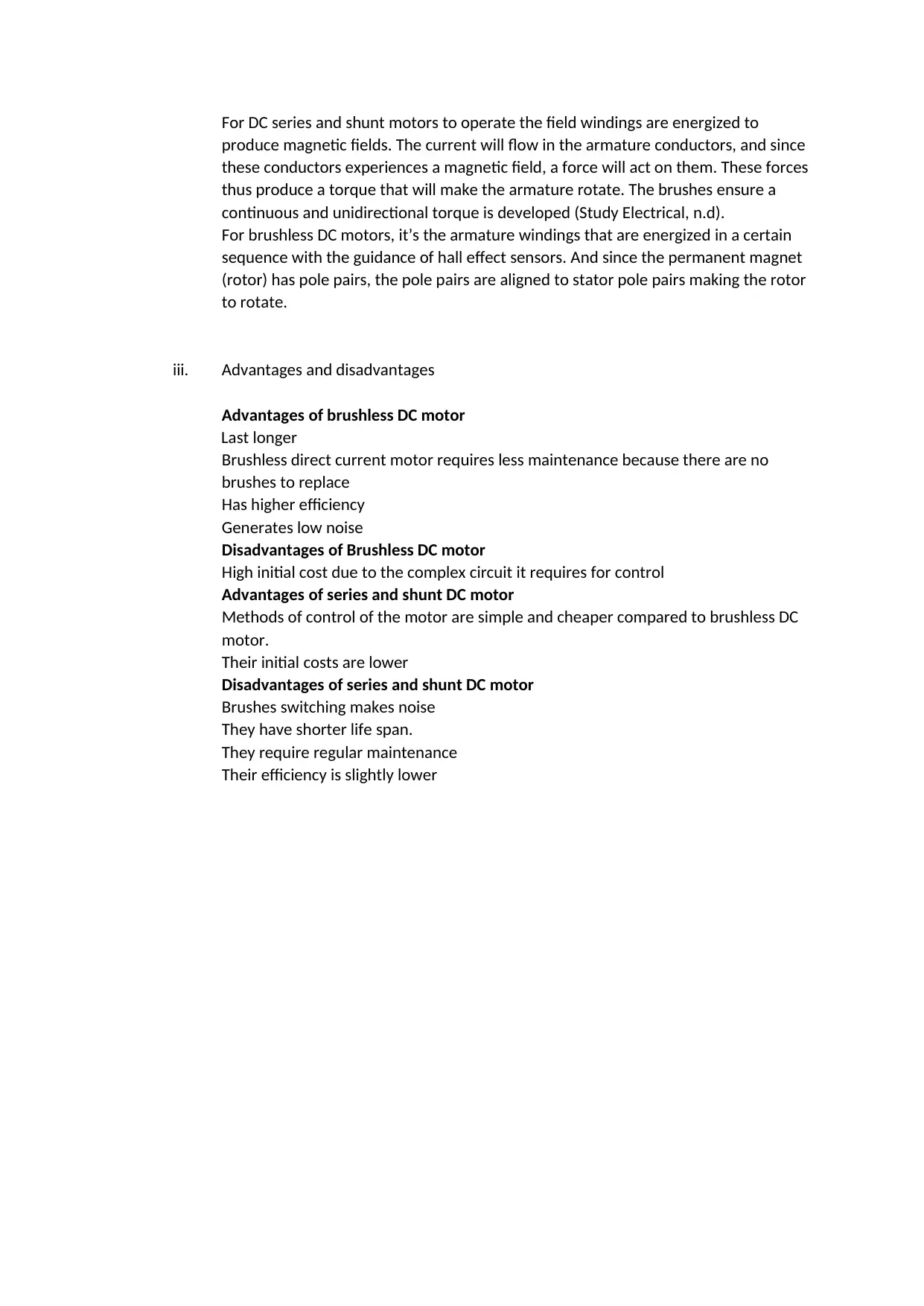
For DC series and shunt motors to operate the field windings are energized to
produce magnetic fields. The current will flow in the armature conductors, and since
these conductors experiences a magnetic field, a force will act on them. These forces
thus produce a torque that will make the armature rotate. The brushes ensure a
continuous and unidirectional torque is developed (Study Electrical, n.d).
For brushless DC motors, it’s the armature windings that are energized in a certain
sequence with the guidance of hall effect sensors. And since the permanent magnet
(rotor) has pole pairs, the pole pairs are aligned to stator pole pairs making the rotor
to rotate.
iii. Advantages and disadvantages
Advantages of brushless DC motor
Last longer
Brushless direct current motor requires less maintenance because there are no
brushes to replace
Has higher efficiency
Generates low noise
Disadvantages of Brushless DC motor
High initial cost due to the complex circuit it requires for control
Advantages of series and shunt DC motor
Methods of control of the motor are simple and cheaper compared to brushless DC
motor.
Their initial costs are lower
Disadvantages of series and shunt DC motor
Brushes switching makes noise
They have shorter life span.
They require regular maintenance
Their efficiency is slightly lower
produce magnetic fields. The current will flow in the armature conductors, and since
these conductors experiences a magnetic field, a force will act on them. These forces
thus produce a torque that will make the armature rotate. The brushes ensure a
continuous and unidirectional torque is developed (Study Electrical, n.d).
For brushless DC motors, it’s the armature windings that are energized in a certain
sequence with the guidance of hall effect sensors. And since the permanent magnet
(rotor) has pole pairs, the pole pairs are aligned to stator pole pairs making the rotor
to rotate.
iii. Advantages and disadvantages
Advantages of brushless DC motor
Last longer
Brushless direct current motor requires less maintenance because there are no
brushes to replace
Has higher efficiency
Generates low noise
Disadvantages of Brushless DC motor
High initial cost due to the complex circuit it requires for control
Advantages of series and shunt DC motor
Methods of control of the motor are simple and cheaper compared to brushless DC
motor.
Their initial costs are lower
Disadvantages of series and shunt DC motor
Brushes switching makes noise
They have shorter life span.
They require regular maintenance
Their efficiency is slightly lower
Paraphrase This Document
Need a fresh take? Get an instant paraphrase of this document with our AI Paraphraser
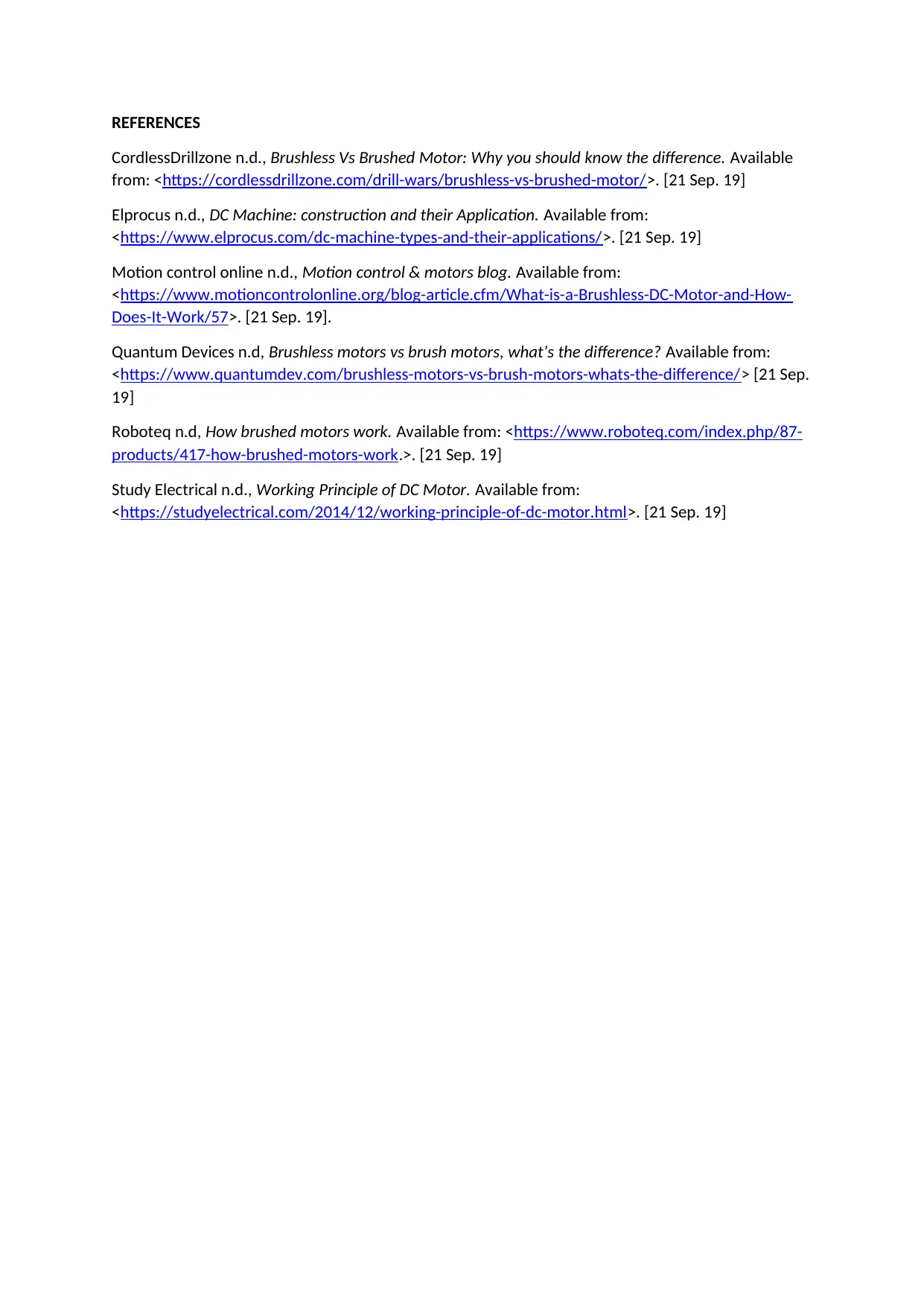
REFERENCES
CordlessDrillzone n.d., Brushless Vs Brushed Motor: Why you should know the difference. Available
from: <https://cordlessdrillzone.com/drill-wars/brushless-vs-brushed-motor/>. [21 Sep. 19]
Elprocus n.d., DC Machine: construction and their Application. Available from:
<https://www.elprocus.com/dc-machine-types-and-their-applications/>. [21 Sep. 19]
Motion control online n.d., Motion control & motors blog. Available from:
<https://www.motioncontrolonline.org/blog-article.cfm/What-is-a-Brushless-DC-Motor-and-How-
Does-It-Work/57>. [21 Sep. 19].
Quantum Devices n.d, Brushless motors vs brush motors, what’s the difference? Available from:
<https://www.quantumdev.com/brushless-motors-vs-brush-motors-whats-the-difference/> [21 Sep.
19]
Roboteq n.d, How brushed motors work. Available from: <https://www.roboteq.com/index.php/87-
products/417-how-brushed-motors-work.>. [21 Sep. 19]
Study Electrical n.d., Working Principle of DC Motor. Available from:
<https://studyelectrical.com/2014/12/working-principle-of-dc-motor.html>. [21 Sep. 19]
CordlessDrillzone n.d., Brushless Vs Brushed Motor: Why you should know the difference. Available
from: <https://cordlessdrillzone.com/drill-wars/brushless-vs-brushed-motor/>. [21 Sep. 19]
Elprocus n.d., DC Machine: construction and their Application. Available from:
<https://www.elprocus.com/dc-machine-types-and-their-applications/>. [21 Sep. 19]
Motion control online n.d., Motion control & motors blog. Available from:
<https://www.motioncontrolonline.org/blog-article.cfm/What-is-a-Brushless-DC-Motor-and-How-
Does-It-Work/57>. [21 Sep. 19].
Quantum Devices n.d, Brushless motors vs brush motors, what’s the difference? Available from:
<https://www.quantumdev.com/brushless-motors-vs-brush-motors-whats-the-difference/> [21 Sep.
19]
Roboteq n.d, How brushed motors work. Available from: <https://www.roboteq.com/index.php/87-
products/417-how-brushed-motors-work.>. [21 Sep. 19]
Study Electrical n.d., Working Principle of DC Motor. Available from:
<https://studyelectrical.com/2014/12/working-principle-of-dc-motor.html>. [21 Sep. 19]
1 out of 5